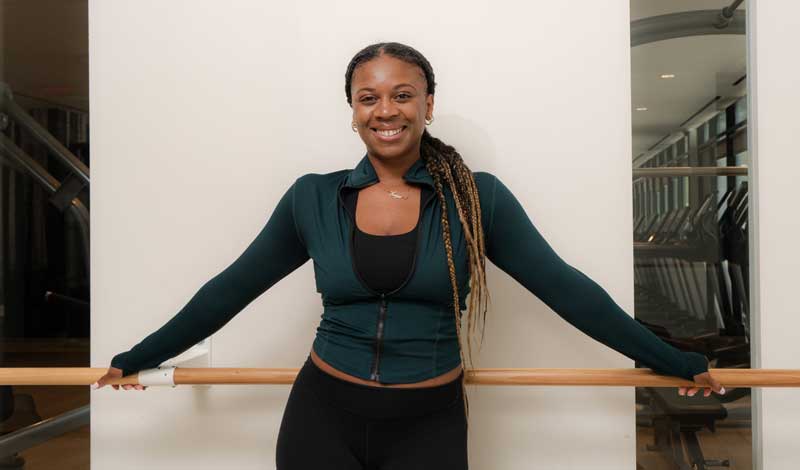by Kaya Wright
Brooklyn, N.Y.
Who knows where it came from, my anxiety. As far as I know, it was with me the day I was born, loud and constant, bursting into occasional panics. It colored every moment, and yet there was one way it could be escaped, one place I could go where no anxious thoughts could find me—where all was calm and quiet. It was where my head would go when it was clasped in headphones, eyes closed: dancing. Noting this, my parents enrolled me in dance camps, where I discovered I could carry the feeling onto the dance floor. It wasn’t until high school that this place—the dance floor—also became a battlefield.
“Kaya, lose 10 pounds,” my teachers told me, matter-of-factly in front of my peers—toned, thin, long-limbed ballerinas. But as a fact, I wasn’t built like them. I began skipping meals, then purging in a cycle of self-hatred broken by short-lived spurts of confidence gained each time I landed a starring role. In such roles, I felt strong, quiet and calm. But as soon as a production wrapped, the self-hatred returned in full force to tell me I was not, in fact, cut from the cloth of dancers.
All my fears and doubts were silenced the day I was accepted to college for dance. The world had spoken and in plain language declared I was enough, my dreams real enough, to matter. It seemed my doubts had run for the hills, to hide, perhaps forever, from such a resounding defeat. They were only nursing their wounds, however, gathering their strength. Within my first semester, they overwhelmed me completely.
It would be fair, I think, to say I’d been among the best in my high school. But here at college, the same could be said for all my peers. Homeschooled and privately tutored, many had lived and breathed dance since childhood, and moved at an astounding pace.
Learning a routine in a week, I’d thought, was the mark of a professional. But here we were often expected to learn it in a day. On the dance floor, I stiffened and withdrew, advertising my fears with every movement. Midstep, I’d freeze, get called out and shrink. Soon I shrank from everyone holing up in my room and skipping classes. Isolated, a feeling built up inside me, of having missed my chance at life. I’d fallen too far behind, I felt, with no way back. I began self-harming and, near the end of the semester, attempted to take my own life. Fortunately, my older sister Harvey sensed something was wrong and called my parents, who brought me home.
I fell into a deep depression, hardly moving. Now and again, I’d try to dance, but found it too painful, reminding me of the person I’d tried to be. And yet, without dance, I did not know who I was. The days passed by, and I hardly left my room, numb and thinking of suicide.
It was at the start of 2021, when I’d begun to self-harm again, that Harvey came into my room and said plainly, “Let’s chant.” I knew she’d begun practicing Buddhism, but this was the first time she’d pressed me to try it too. Actually, she’d come home the same semester as I had, also to tend to her mental health. It was clear to me that whatever she was doing was helping her in a way that nothing had yet helped me. Slowly, I pushed myself up and followed her lead. I didn’t know what Nam-myoho-renge-kyo meant. I didn’t even know if I was pronouncing it right. But the first time I chanted, I felt something I couldn’t really describe. After years of numbness, any feeling other than self-inflicted pain would have been hard to describe. But I felt that there was something bigger than myself that was protecting me. Whatever it was, I knew I wanted to feel it again. Five minutes became 10, and 10 became 20, and soon enough I realized I was looking forward each day to my chanting.
Slowly, I began to move again, to dance a little in my room, moving not to punish my body but to connect with it, in a way we hadn’t connected in years, maybe since childhood—on my own terms, for its own sake. Within a few months’ time, I was introduced to a new kind of movement. My mother invited me down to the park in front of our house to meet the personal trainer she worked with every week. We spoke and in a short while I realized that it was something I might want to try.
I began to train—free weights and weighted exercises—with a personal trainer. It was a new kind of movement for me and one I quickly became passionate about. That same year, I began working an entry-level job at a studio and within six months was certified to teach and was hired on as a trainer myself. Within a year, I was a top trainer in the company, with a full roster of clients. I was feeling better, more aligned with myself by the day, and yet, there were times I backslid, fell into a depression, stopped chanting and even began to self-harm again.

At these times, Harvey would press me to join a get-together with her and the SGI community, but I’d always shrug. “I feel the difference,” I’d say. “I’m good.”
“But you’re not,” she’d say. “Stop isolating.”
But I was focused on getting out of my own head. And I didn’t need others, I thought, to do that.
It wasn’t until the start of this year, in January, that I came out to a meeting and saw for myself what Harvey had been a part of. Actually, I went for her, not the community—she was performing in a band at the new year’s kickoff. We all went—my dad, my mom, my younger sister, Soleil and me. It was my first time seeing the community, and I was amazed by what I felt and saw—the happiest, most energetic community I’d come across.
At the meeting, they handed out cards for new year’s resolutions. On mine I wrote, among other things: “To receive the Gohonzon.” Just this month, I did.
Getting involved in the community has been a game changer. It wasn’t anything dramatic, really—just little conversations with people, hearing how they’d overcome their own challenges, realizing, when I felt alone in my suffering, that in fact others were battling too. It helped me keep a consistent practice and stay accountable to myself. I began studying and developing my own connection with the practice. My prayer has changed and with it my mind. I’m building my happiness, but no longer alone. In community, I feel my life entering a new kind of motion—a joy I’m taking with me wherever I go.
You are reading {{ meterCount }} of {{ meterMax }} free premium articles

